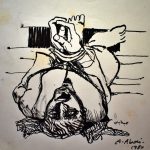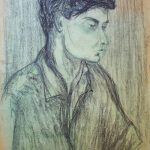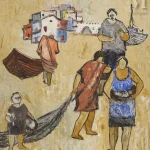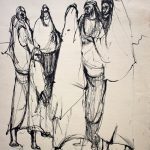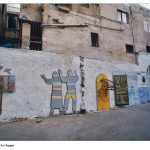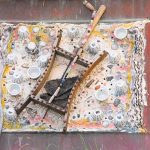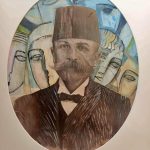
by Aline Khoury
And [identity] involves both the personal and the collective. It offers a sense of belonging and a sense of distinction. (The distinction being what distinguishes each one of us.) A true identity implies continuity; it evokes ancestors and heirs, the dead and the as yet unborn. And, at the same time, it frames a here and now which is a ME at every transient moment.”
John Berger, ‘Concerning Identity’ in: Kamal Boullata, Palestinian Art From 1850 to the Present, London 2009, p. 16.
Palestinian art history is largely characterized by fragmentation, both in style and content, which is a result of ongoing wars and displacement of people. Despite historical ruptures in time and space, artists have flourished in a multitude of voices and places to create a vibrant Palestinian art scene. The featured works by Abed Abdi (Lot 77), Samira Badran (Lot 78) and Asim Abu Shakra (Lot 79) are archetypal of Palestinian art in the aftermath of war, reflecting unique and distinct styles expressing the broad struggles and experiences of the Palestinians.
The Nakba (Arabic for ‘catastrophe’) in 1948 was a defining moment in Palestinian history that affected the life, culture and identity of the Palestinian people in immeasurable ways, and concurrently, the evolution of Palestinian art. Palestinian art was still in its early stages of development in the mid-1900s as pioneer artists started to move away from the long-standing tradition of Christian icon painting to explore secular genres through new techniques and forms of image-making. Shortly thereafter, such novel changes in the aesthetics of Palestinian art were obstructed by the 1948 War. The destruction and wounds were deep, with Palestinian painting only remerging over a decade later, yet in a different and political form with mere threads of continuity from the past.
In the mid-1960s, the Palestine Liberation Organization (PLO) was established, strengthening the spirit of Palestinian nationalism. Subsequently, Palestinian artist unions and leagues were formed, organizing exhibitions that travelled internationally to raise awareness for the national struggle. Themes of expulsion, displacement and nostalgia for the homeland dominated artworks from the period.
In the backdrop of the nationalist art movement, artists were increasingly exposed to art education and western influences that paved way for individualistic styles to emerge by a new generation of artists working locally and in exile. Renowned Palestinian art historian, Kamal Boullata, describes artists from this period (1965-1995) as “the explorers”, who, wherever they lived, “sought to articulate their personal predicament in relation to the collective dream of regaining their homeland” (Kamal Boullata, ‘Art’ in: Philip Mattar, Ed., The Encyclopedia of the Palestinians, New York 2005, n.p.), which is manifested in the works of Abdi, Badran and Abu Shakra.
Abed Abdi was born in Palestine in 1942. At the age of six he became a refugee, wandering from one refugee camp to another between Lebanon and Syria. Three years later, he had the fortune of returning to his homeland as part of a family reunification program. His childhood experience remained with him and throughout his artistic practice he portrayed the hardships of the expulsion and displacement. He is most notably known as the first Palestinian artist living in Israel to erect monumental works in public spaces to commemorate Palestinian modern history that are still standing in Palestinian towns and villages.
Similar to Abdi, Asim Abu Shakra lived and worked in Israel; however, born two decades later, he learnt about the Nakba and the lost homeland through oral history. He was born into a Palestinian family in the village of Umm el-Fahem in northern Israel, spoke Hebrew from a young age and later pursued his art education in Tel Aviv. The complexities of being a refugee within one’s own homeland, living in between two contradictory and clashing identities, played a significant role in the development of Abu Shakra’s expressive and symbolic work. Sadly his prolific career was tragically cut short due to cancer at the age of 28.
Samira Badran on the other hand, was born in Tripoli, Libya, to the late Palestinian craftsman Jamal Badran, who fled from Haifa during the Nakba. Her dream of returning to Palestine was realized when the Badran family moved to the West Bank and the city of Ramallah, only to witness the 1967 War. Although Badran currently lives and works in Barcelona, her abstract paintings filled with enigmatic imagery of apocalyptic visions reflect on the distressing realities and traumas experienced by her family.
Through their individualistic styles and aesthetics, Abdi, Badran and Abu Shakra each left and continue to leave a mark on Palestinian art history. While they portray personal experiences and inner conflicts, their works speak towards a broader collective struggle of the dispersal and fragmentation of Palestinian society after the 1948 War and its effects today.
Abed Abdi is a prominent Palestinian artist who has played a significant role in the advancement of art among Palestinians living in Israel. In the wake of the 1948 War, Abdi was forced to flee from Haifa with his mother and siblings, spending the following three years in refugee camps. In his youth, Abdi was an active member of the Communist Party, joining the Youth Alliance in Haifa where he learnt painting and sculpture. His participation opened up various opportunities, including his first exhibition in Tel Aviv and later admittance to the Academy of Fine Arts in Dresden in the German Democratic Republic (1964-1972).
While a student in Germany, Abdi’s early works were predominantly black and white graphic illustrations and etchings portraying themes on the uproot and displacement of Palestinians. In Expulsion from the Homeland, Abdi begins to introduce colour in a manner reminiscent of the expressionist art movement to depict a familiar scene from his childhood experience. Abdi experiments by using different brushstrokes and techniques, including etching away from the wet paint for outlines and movement. Shades of reds and yellow overtake the landscape as abstracted gray and brown bodies move towards the unknown horizon searching for refuge. A couple of figures look back grasping the viewer’s gaze with their bleak expressions as we witness the death and suffering from the war, leaving us to question the fate of the living.
Following his studies and return to Haifa, Abdi worked as an illustrator and designer for Arabic publications like Al Ittihad newspaper and Al Jadid literary journal to make a living, while continuing his art practice and participation in several local and international exhibitions. Abdi has been awarded several prizes for his contribution to the city, including the Herman Struck Best Art of the Year Prize twice (1973 & 1999), and the Young Artist Award at Berlin International Youth Festival (1973), amongst others. Abdi continues to live and work in his studio in Haifa.
published in : Sotheby’s: 20th Century Art / Middle East / Catalog note / 2019


